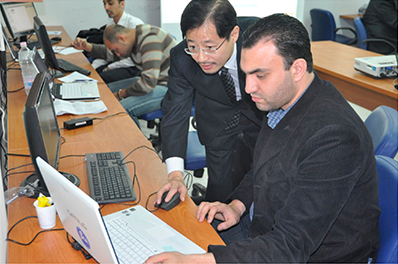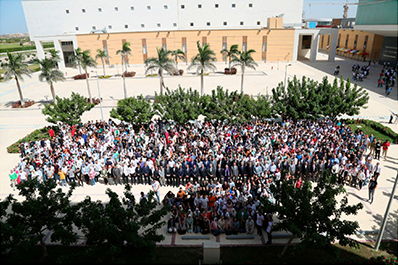Stories from the Field 03
Establishing a University of Science and Technology in Egypt that Implements the Japanese Education System
—A Contribution toward the Development of the Middle East and Africa by Fostering and Producing Excellent Researchers—

Dr. Ookawara teaching an Egyptian student in his class

The entrance ceremony of E-JUST in October 2022 (Photo: E-JUST)
In Egypt, the lack of experimental and practical equipment at universities due to the increase in the number of university students had an impact on the teaching methods employed. In particular, in the Faculty of Engineering, lecture-style education through classroom learning has been the norm, with only a limited number of universities offering practical education. In response to a request for support from the Government of Egypt to establish a new university based on the concept of “offering small class sizes, postgraduate and research-oriented, practical, and international standard of education,” which are the characteristics of Japanese-style engineering education, Japan launched the technical cooperation project “Egypt-Japan University of Science and Technology (E-JUST)” in 2008.
During Phase 1 of the project, from October 2008 to January 2014, assistance was provided mainly in the areas of developing curriculum and dispatching experts and professors, in cooperation with 12 Japanese universities including Kyushu University, Kyoto University, Tokyo Institute of Technology, and Waseda University. It led to the establishment of E-JUST in 2009 as a graduate university specializing in engineering-related fields. In Phase 2 of the project implemented from February 2014 to January 2019, the Faculty of Engineering as well as the Faculty of International Business and Humanities were established and began accepting undergraduate students. This made a solid foundation for E-JUST to become a top-class research university in Egypt that promotes human development and contributes to the development of Egyptian industry and society. In the earlier stages of the project, there was confusion among the Egyptian faculty members about the concept of the university. However, once the Japanese-style laboratory-based education began to show positive results, the Egyptian faculty members’ commitment to implementing the new style and the learning attitude of the students showed positive changes.
Dr. OOKAWARA Shinichi, Specially Appointed Professor of the Tokyo Institute of Technology, talks about the achievement of the E-JUST project as follows: “As a result of continuous and consistent research supervision provided through the project, the Japanese-style educational method was highly evaluated, and the number of students has grown from 30 to 3,000 today. When I participated in a forum of Egyptian universities, the E-JUST booth was given a prominent location at the venue and the Egyptian Minister of Higher Education and Scientific Research visited our booth, which made me realize that our efforts were highly appreciated.”
Dr. Ookawara has accepted doctoral students from E-JUST at his lab at the Tokyo Institute of Technology every year, and provides beneficial opportunities for E-JUST students to experience research life through cutting-edge research in Japan, as well as for Japanese students to acquire international perspectives.
Thereafter, several Egyptian universities were established modelled on E-JUST. This situation proves that the concept of E-JUST has been widely accepted in Egypt. Professor Emeritus SUZUKI Masaaki of the Tokyo Institute of Technology, who serves as the first vice president of E-JUST, talks about his prospects in the future as follows: “E-JUST has now developed into one of the top research universities in Egypt. In Phase 3 of the project (February 2019 – January 2025), we would like to contribute to the development of African countries by accepting more international students from Africa while taking advantage of the existing and newly created scholarship programs.”
<< Previous Page Next Page >>
Main Text | Reference Statistics | Appendix | Stories from the Field | Master Techniques from Japan to the World | ODA Topics
